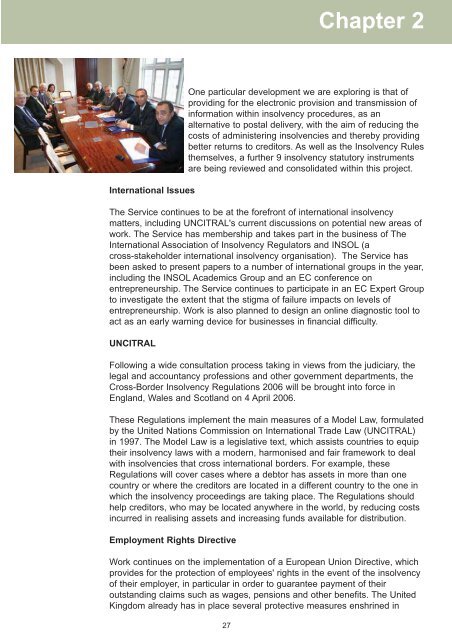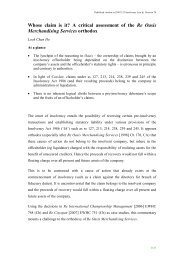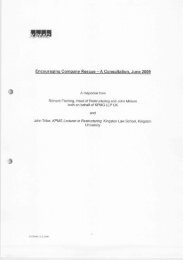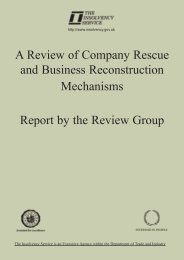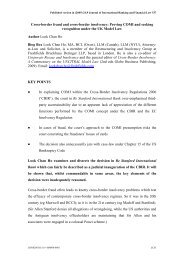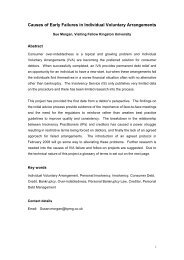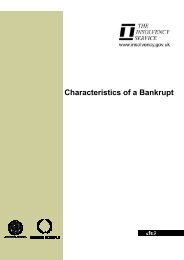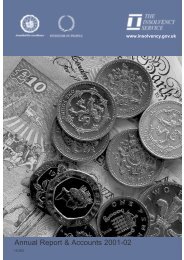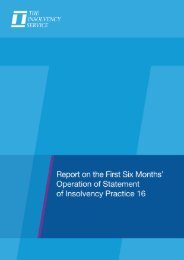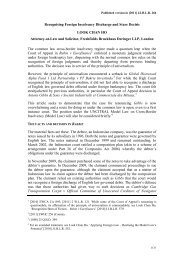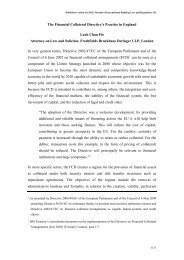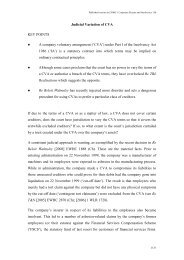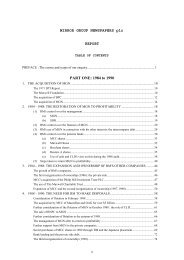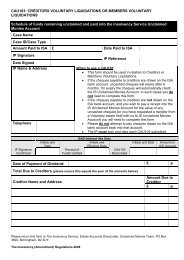Chapter 2 - The Insolvency Service
Chapter 2 - The Insolvency Service
Chapter 2 - The Insolvency Service
Create successful ePaper yourself
Turn your PDF publications into a flip-book with our unique Google optimized e-Paper software.
<strong>Chapter</strong> 2<br />
International Issues<br />
One particular development we are exploring is that of<br />
providing for the electronic provision and transmission of<br />
information within insolvency procedures, as an<br />
alternative to postal delivery, with the aim of reducing the<br />
costs of administering insolvencies and thereby providing<br />
better returns to creditors. As well as the <strong>Insolvency</strong> Rules<br />
themselves, a further 9 insolvency statutory instruments<br />
are being reviewed and consolidated within this project.<br />
<strong>The</strong> <strong>Service</strong> continues to be at the forefront of international insolvency<br />
matters, including UNCITRAL's current discussions on potential new areas of<br />
work. <strong>The</strong> <strong>Service</strong> has membership and takes part in the business of <strong>The</strong><br />
International Association of <strong>Insolvency</strong> Regulators and INSOL (a<br />
cross-stakeholder international insolvency organisation). <strong>The</strong> <strong>Service</strong> has<br />
been asked to present papers to a number of international groups in the year,<br />
including the INSOL Academics Group and an EC conference on<br />
entrepreneurship. <strong>The</strong> <strong>Service</strong> continues to participate in an EC Expert Group<br />
to investigate the extent that the stigma of failure impacts on levels of<br />
entrepreneurship. Work is also planned to design an online diagnostic tool to<br />
act as an early warning device for businesses in financial difficulty.<br />
UNCITRAL<br />
Following a wide consultation process taking in views from the judiciary, the<br />
legal and accountancy professions and other government departments, the<br />
Cross-Border <strong>Insolvency</strong> Regulations 2006 will be brought into force in<br />
England, Wales and Scotland on 4 April 2006.<br />
<strong>The</strong>se Regulations implement the main measures of a Model Law, formulated<br />
by the United Nations Commission on International Trade Law (UNCITRAL)<br />
in 1997. <strong>The</strong> Model Law is a legislative text, which assists countries to equip<br />
their insolvency laws with a modern, harmonised and fair framework to deal<br />
with insolvencies that cross international borders. For example, these<br />
Regulations will cover cases where a debtor has assets in more than one<br />
country or where the creditors are located in a different country to the one in<br />
which the insolvency proceedings are taking place. <strong>The</strong> Regulations should<br />
help creditors, who may be located anywhere in the world, by reducing costs<br />
incurred in realising assets and increasing funds available for distribution.<br />
Employment Rights Directive<br />
Work continues on the implementation of a European Union Directive, which<br />
provides for the protection of employees' rights in the event of the insolvency<br />
of their employer, in particular in order to guarantee payment of their<br />
outstanding claims such as wages, pensions and other benefits. <strong>The</strong> United<br />
Kingdom already has in place several protective measures enshrined in<br />
27


